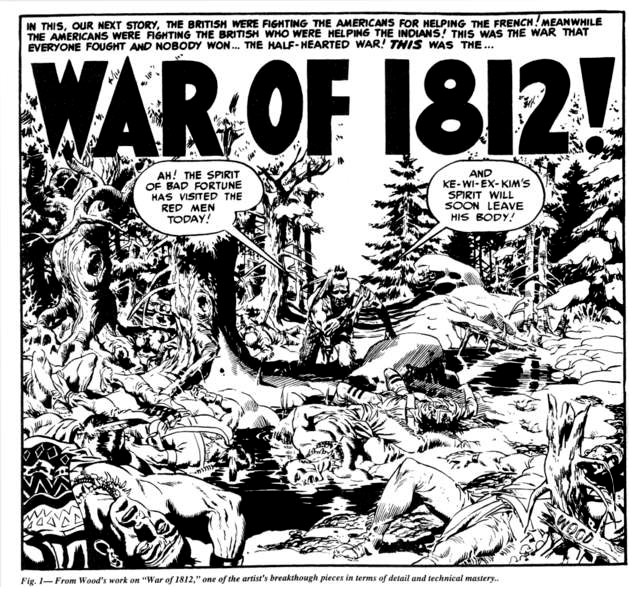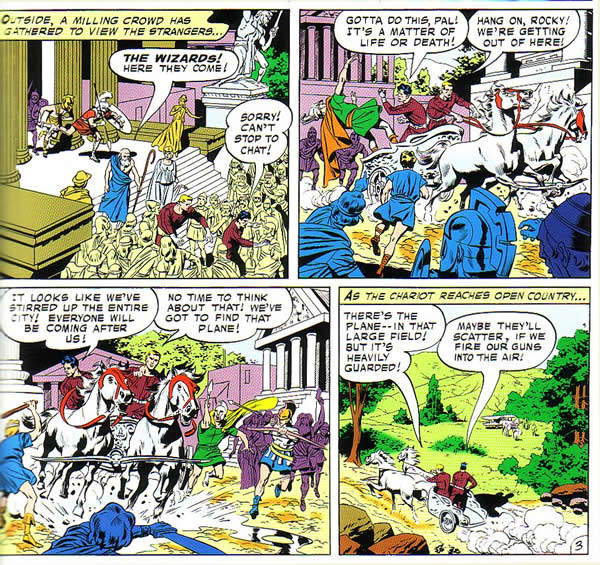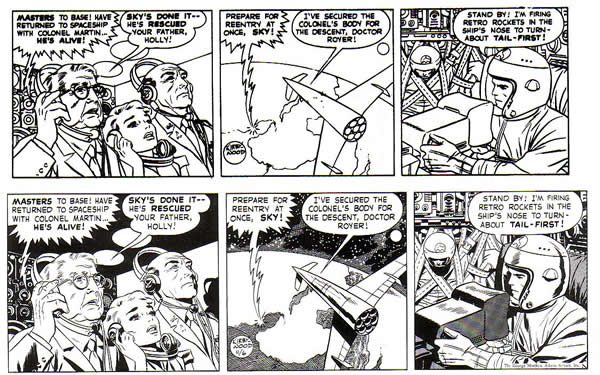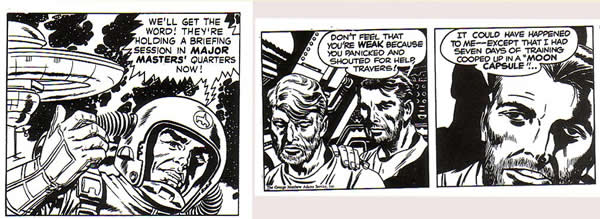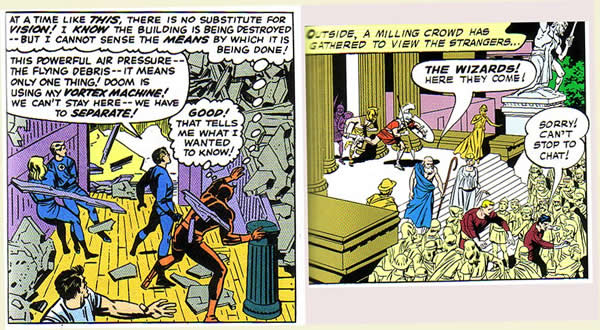Some time around 1954, work in the field of comic books began to grow scarce, even for the formerly lucrative team of Joe Simon and Jack Kirby. When Simon became an editor for Harvey Publications, the dynamic duo went their separate ways. Kirby struggled to find work, approaching the newspaper syndicates with proposals for strips. In 1956, he returned to work for National Periodicals, developing such ideas as Green Arrow and Challengers of the Unknown.
At some point following the breakup of the team, Jack Kirby’s style began to undergo a series of gradual changes that would alter the look of his figures and the design of his pages. Kirby’s heroes had always possessed a lithe sinewy and somewhat elongated musculature. Beginning somewhere in the mid to late fifties, Kirby’s artwork began to bulk up and to take on a more architecturally geometric quality. Coincidentally around this time, Kirby’s pencils were coupled with the embellishment of an inker of extraordinary skill who was a legendary draftsman in his own right.This was the remarkable Wallace Wood, who had honed his skills with EC Comic’s groundbreaking storytelling.
The unique partnership debuted on the aforementioned series Challengers of the Unknown, a series often considered a forerunner of Lee and Kirby’s Fantastic Four. Kirby soon realized his dream to pen a newspaper strip, one Sky Masters, which was also inked by Wood. Wally Wood is usually described as an intense workaholic who labored obsessively over his pages. In an article in The Comics Journal #197, author Bill Mason says this of Wood’s development as an artist.
“The young Wood taught himself how to draw in a dashing, boldly exaggerated style which he gradually refined by adjusting the spatial relationships in his drawing, through an extremely laborious process of point to point navigation from one solid object to another.”
You can see in the intricacy of this panel just what Mason is talking about. There is literally no space in this composition that is not being used to maximum advantage. From the pine trees in the background to the gnarled branches and stumps to the scattered figures of the dead with their artfully arranged limbs and the shadows they cast, all the panel shapes are precisely arranged with dark and light almost perfectly balanced.
The ability to do this sort of spatial structuring is something that Wood had in common with Jack Kirby, who is generally regarded as someone who drew seemingly with no effort or preparation. This may be the case for the latter portion of his career, when he had more or less mastered his craft, but having seen some examples from his early swipe file, I believe that Kirby worked extensively on his depiction of reality. One notable example is Robert Riggs illustration that Kirby used for a cover for Police Trap #2. The figures that Kirby more or less copied, who are standing in a station house show a serious concern with the understanding of the arrangement of deep space.
I believe that Kirby’s artistic collaboration with Wallace Wood on Challengers and Sky Masters had a profound effect on Kirby’s approach to his work. Wood’s obsession with the meticulous arrangement of spatial relationships reinforced a similar tendency in Kirby, who became for the next ten years increasingly more proficient at utilizing every object placed on his page to maximum compositional advantage.
I also believe that Wood’s mastery of black spotting affected Kirby’s perception of and use of dark and light in his pencils.
Kirby first worked with Wood on issue #4 of Challengers of the Unknown. The previous issue is inked by Marvin Stein, and while there are backgrounds, they are a bit uninspired by Kirby standards. Wood’s inking of the following issue shows us that we are in for something completely different. In this splash panel, there is an almost geometric arrangement of the figures emerging from the background.
In the Stein inked pages, the machinery that Kirby draws function as a device to establish setting and has only a secondary design purpose. Wood’s inspired rendering seems to usher in the first era of techno-Kirby, where nearly all surfaces of all objects and in particular machinery, are covered with detail that serve primarily a design function.
In this first story, A Wizard in Time, The Challengers travel back to ancient Egypt and Rome. In the Roman setting, Kirby really uses panel space to full advantage, constructing small windows into elaborate mini worlds. One can observe the wealth of compositional detail in this scene on the steps of the Roman forum. All the successive panels are densely populated with objects that are reminiscent of the description of Wood’s system of point to point navigation.
It is difficult to know to what degree these changes in Kirby’s work are due to Wood’s inking. Certainly, it is easy for an artist of Wood’s caliber to embellish surfaces such as machinery and add touches such as highlights to faces, but more seems to be happening here. Kirby appears to be composing his panels in anticipation of Wood’s inking because he knows what Wood does best.
This becomes even more apparent on the next feature that the two artists collaborated on, the newspaper strip, Sky Masters of the Space Force.
An invaluable artifact from that series gives us an incredible insight into the Kirby/ Wood combination. There is a Photostat of a page in process, inked partially by Wood with simply a pen outline. With this sample one can clearly see that Kirby did not spot blacks for his inker, preferring to leave these decisions for Wood to make.
There is ample evidence that Kirby sought out Wood as THE Inker for this strip and this sample clearly shows us why. Wood is a masterful spotter of blacks, using a combination of solid shadows and gray tones to bring Kirby’s drawings to vivid life. If one looks at the area suggesting atmosphere surrounding planet earth, one can see something vaguely like what would eventually become known as Kirby krackle. This substance does not appear in the pencils. This is something that Wood has added as an effect as he has positioned his blacks, and he uses it liberally to give that cosmic quality to his work. One can see it used again in an even more Kirby-like way in the head and hand shot below.
Is it possible that Kirby was inspired by Wood to use Krackle in his cosmic art?
The other noteworthy aspect of this same panel is the way that Wood uses shadows in the dramatic highlights on the right side of the astronaut’s face. This is characteristic of Wood’s chiaroscuro shading techniques.
It is practically a signature for Wood as an instantly recognizable technique. When Wood left the strip, Kirby took over inking chores for several months.
If you look at the two panels to the right of the gesturing astronaut, you can see Kirby’s attempt in his inking to mimic Wood’s facial shading technique.
Kirby ceased his double duty art chores when Dick Ayers took over as inker on Sky Masters a few months later.
At some point thereafter, Kirby began spotting blacks in his penciling. It may be overreaching to suggest that his time working with Wood and then carrying on as inker in Wood’s absence influenced Kirby’s approach to dealing with dark and light, but I believe this to be the case. I strongly feel that Kirby was favorably impressed by both Wood’s strong sense of composition and his powerful use of black and white contrast. Although he never used the sort of realistic shading that Wood was famous for, Kirby became a powerful black spotter and never again left such important artistic decisions to his inkers.
Wood seldom ever inked Kirby again, but a notable exception was issue #39 of the Fantastic Four, in which Wood only inked the figure of Daredevil, a series he was drawing at the time. The remainder was inked by Frank Giacoia
Given my penchant for finding correlations between things, I see a similarity in the compositions of these two panels, separated in time by more than five years.
As a matter of fact, this entire story, which opens on board a nuclear submarine is a high point in visual Kirby-tech that seems to be a bow in the direction of Wood’s style. It feels to me as if initially in the late fifties, Wood’s inking had an impact on Kirby as the King segued into the Marvel years. Then, their later collaboration on the Daredevil issue of the Fantastic Four re-ignited something in Kirby’s mind. From that point on, he begins to draw in an even more panoramic style. His machinery and architecture become more elaborate and he begins to delve even further into deep space composition. Panel count also grows smaller as panels become larger and more complex.
In FF#39, Kirby has penciled the Thing in such a way that has compelled Frank Giacoia to ink him in the rock-like and dimensionally shaded fashion in which he will henceforth be rendered. This issue is notable for the density of its blacks.
The earlier Chic Stone issues have a higher panel count and the figures within the panels are generally smaller. From #39 on, through the Colletta issues and into the Sinnott run, one can see the difference in the intensity and scope of Kirby’s pencils. I attribute this gradual and then sudden change to the influence of Wally Wood.
This 39th issue of the Fantastic Four is dated June 1965. Wally Wood left Marvel soon after to begin working for Tower Comics. The rival publisher’s first issue T.H.U.N.D.E.R. AGENTS debuted in November 1965. Kirby may have felt the pressure from his one time collaborator to ramp up his own efforts and out-Dynamo the competition. At any rate, Kirby and Marvel kicked their already revved up line into high gear, as 1965 was the beginning of comic book storytelling at an intergalactic level.
Although the evidence is circumstantial, I suggest that Kirby plus Wood equals evolution.
Citations
1 – Wood, Wally (art) Kurtzman, Harvey(story), “War of 1812”, Frontline Combat #6, reprinted in The Comics Journal #197, Bill Mason article, “A Thousand Rays of Light in Your Belly”, Wally Wood at EC 1952-54, Fantagraphics, July 1997
2 – Kirby, Jack, “The Wizard of Time”, Challengers of the Unknown #4, DC reprint from DC Challengers of the Unknown, Archive Edition, Volume 2, 2004, pg. 35
3 – Ibid. pg. 43
4 – Kirby, Jack (art) Wood, Dave, Wood, Dick (story) Wood, Wally (inks) The Complete Sky Masters, Pure Imagination.
5 – Ibid
6 – Lee, Stan (story) Kirby, Jack (art) Wood, Wally (inks) Giacoia, Frank (inks) Simek, Artie (lettering)Fantastic Four #39, “A Blind Man shall Lead Them” page #16, The Villainy of Dr. Doom, Marvel Comics, 1999
7 – Ibid. pg.#14
8 – Ibid. pg#6


